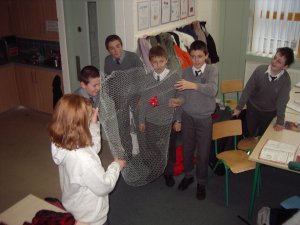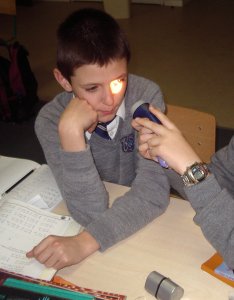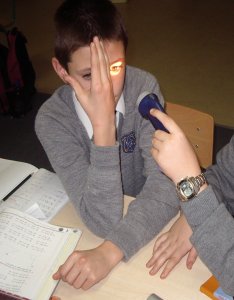|
Experiment
No. 9
The Brain
- Reflexes
As
mentioned in our last experiment, the brain controls everything
we do, say or think by sending messages along our nerves. These
electrical signals travel all around our body at great speed.
In fact the nervous system is your body's decision and communication
center. The central nervous system is made of the brain and
the spinal cord and the peripheral nervous system is made of
nerves. Together they control every part of your daily life,
from breathing and blinking to helping you memorize facts for
a test. Nerves reach from your brain to your face, ears, eyes,
nose, and spinal cord... and from the spinal cord to the rest
of your body.
Sensory
nerves gather information from the environment, send that information
to the spinal cord, which then speeds the message to the brain.
The brain then makes sense of that message and fires off a response.
Motor neurons deliver the instructions from the brain to the
rest of your body. The spinal cord, made of a bundle of nerves
running up and down the spine, is similar to a superhighway,
speeding messages to and from the brain at every second.
There
are times however that the brain and central nervous system
takes over and performs an action without our input. In other
words, the brain and CNS cause an action to happen without us
thinking about it. Sometimes this helps protect us - like blinking
our eyes as something approaches our face. If we touch something
very hot, we immediately withdraw our hand without thinking.
These are reflex actions that are there to protect us.
Sixth
Class have been looking at our reflexes. |
Experiments:
To check out our reflexes.
Firstly,
we looked at the pupil - that black hole in the centre of the eye.
This little hole allows light to enter and is
carefully controlled. If there is a lot of light in front of the eye,
the pupil becomes smaller. In dark conditions, it
becomes wider.
Using torches,
we checked out our pupils. We shone a torch into the eye and noted
the pupillary response: it
"automatically" keeps out excessive light that may damage
the eye. Interestingly both eyes reacted together -
even though the torch only shone into one eye at a time.
Our
second experiment was
a bit of fun! One of the class stood behind a barrier - in this case,
some chicken wire - and
their classmates threw bean bags at him!! The idea was to stand still
and not react. In all cases, if our 'target' didn't
jump out of the way, at the very least he blinked his eyes! Take a
look at the photo below.

Our third
reflex experiment was the famous 'knee jerk'
The knee jerk reflex is one we are are familiar with...
the doctor hits your knee and your leg kicks out. We tried it! We
had a partner sit with his or her legs crossed so that
their leg could swing freely. The leg was hit just below the knee
with the side of a hand. PLEASE DO NOT USE A
HAMMER!!!! The leg will kick out immediately (if you hit the rightplace).
The
knee jerk reflex is called a monosynaptic reflex. This means that
there is only 1 synapse in the neural circuit
needed to complete the reflex. It only takes about 50 milliseconds
of time between the tap and the start of the legkick...that is fast.
The tap below the knee causes the thigh muscle to stretch. Information
is sent to the spinal cord.
After one synapse in the ventral horn of the spinal cord, the information
is sent back out tothe muscle...
and there you have the reflex. The brain is bipassed - we don't think
about this reflex - it just happens.

Finally,
as I was teaching quietly, I suddenly slammed a large and heavy book
on to a desk at the front of the class.
We then counted the number of students who:
Twitched
Moved their heads
Blinked their eyes
Put their hands up
Screamed
Reflexes
are used to protect the body without us having to think about what
is happening...reflexes get us away from
objects that might hurt us, before they hurt us. For example, if you
put your hand on a hot stove, you immediately
remove your hand BEFORE the message, "Hey, my hand is on a hot,
burning cooker", gets to your brain.
Our
Experiments
|
| |




